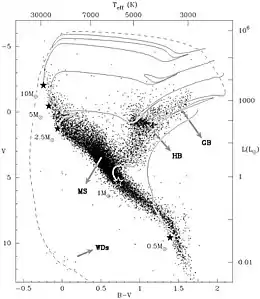Super-AGB star
A super-AGB star is a star with a mass intermediate between those that end their lives as a white dwarf and those that end with a core collapse supernova, and properties intermediate between asymptotic giant branch (AGB) stars and red supergiants. They have initial masses of 7.5–9.25 M☉ in stellar-evolutionary models, but have exhausted their core hydrogen and helium, left the main sequence, and expanded to become large, cool, and luminous.

HR diagram
Super-AGB stars occupy the top-right of the Hertzsprung–Russell diagram (HR diagram), and have cool temperatures between 3,000 and 4,000 K, which is similar to normal AGB stars and red supergiant stars (RSG stars).[1] These cool temperatures allow molecules to form in their photospheres and atmospheres.[2] Super-AGB stars emit most of their light in the infra-red spectrum because of their extremely cool temperatures.
The Chandrasekhar limit and their life
A super-AGB star's core may grow to (or past) the Chandrasekhar mass because of continued hydrogen (H) and helium (He) shell burning, ending as core-collapse supernovae.[1][3] The most massive super-AGB stars (at around 9 M☉) are theorized to end in electron capture supernovae. The error in this determination due to uncertainties in the third dredge-up efficiency and AGB mass-loss rate could lead to about a doubling of the number of electron-capture supernovae, which also supports the theory that these stars make up 66% of the supernovae detected by satellites.
These stars are at a similar stage in life to red giant stars, such as Aldebaran, Mira, and Chi Cygni, and are at a stage where they start to brighten, and their brightness tends to vary, along with their size and temperature.
These stars represent a transition to the more massive supergiant stars that undergo full fusion of elements heavier than helium. During the triple-alpha process, some elements heavier than carbon are also produced: mostly oxygen, but also some magnesium, neon, and even heavier elements, gaining an oxygen-neon (ONe) core. Super-AGB stars develop partially degenerate carbon–oxygen cores that are large enough to ignite carbon in a flash analogous to the earlier helium flash. The second dredge-up is very strong in this mass range and that keeps the core size below the level required for burning of neon as occurs in higher-mass supergiants.
References
- Groenewegen, M. A. T.; Sloan, G. C. (2018). "Luminosities and mass-loss rates of Local Group AGB stars and red supergiants". Astronomy & Astrophysics. 609: A114. arXiv:1711.07803. Bibcode:2018A&A...609A.114G. doi:10.1051/0004-6361/201731089. S2CID 59327105.
- Levesque, Emily M.; Massey, Philip; Olsen, K. A. G.; Plez, Bertrand; Josselin, Eric; Maeder, Andre; Meynet, Georges (2005). "The Effective Temperature Scale of Galactic Red Supergiants: Cool, but Not as Cool as We Thought". The Astrophysical Journal. 628 (2): 973–985. arXiv:astro-ph/0504337. Bibcode:2005ApJ...628..973L. doi:10.1086/430901. S2CID 15109583.
- Poelarends, A. J. T.; Herwig, F.; Langer, N.; Heger, A. (2008). "The Supernova Channel of Super‐AGB Stars". The Astrophysical Journal. 675 (1): 614–625. arXiv:0705.4643. Bibcode:2008ApJ...675..614P. doi:10.1086/520872. S2CID 18334243.
attribution contains text copied from Asymptotic giant branch available under CC-BY-SA-3.0